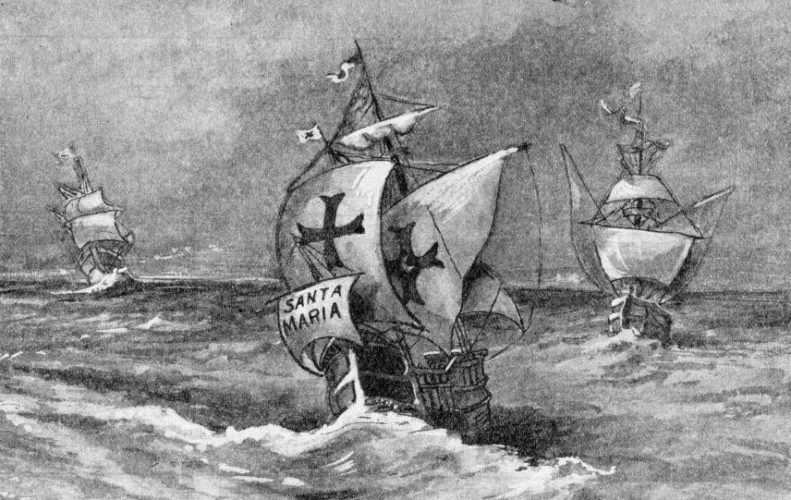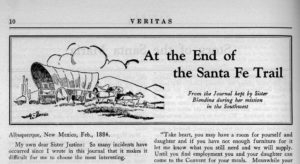Sister Blandina and the Santa Maria Institute

August 22, 1897. “Sister,” said Mother Mary Blanche, one day while several Sisters were standing around waiting an opportunity to consult her, “I have been wanting to ask you something for some time, and I’ll do it now lest I forget it. I have been wondering if you and Sister Blandina could do anything for the poor Italian children of the city? I have thought of it so often, and when I saw you both kneeling in the chapel it occurred to me that you could do a great deal for them. (Veritas, March 1929)
This past summer, the Sisters of Charity of Cincinnati archives was able to digitize our entire collection of Veritas and Santa Maria newsletters from the Santa Maria Institute through an Ohio Archives Grant received from the Ohio Historical Records Advisory Board. Given the extreme rarity of this publication and the multitude of subjects it addresses, having the digital collection available through Ohio Memory has brought an entirely new resource to light to scholars from a variety of fields.
We’re excited to provide some context to the institution from which the newsletters emanated along with the stories they hold that will shed light on the life of Sisters Blandina and Justina Segale and the broader mission work of the Sisters in Cincinnati, the American Southwest, and beyond!
Here I am safe in Trinidad, Colorado Territory, instead of in the island of Cuba where we first thought I was to go. No wonder this small pebble (Trinidad, Colo.) is not on our maps. “Angels guide your footsteps.” This sentence has stayed with me from the time I left the archbishops residence in Cincinnati and is with me still. (Veritas, January 1927)

A familiar name that is garnering recognition, which will continue to increase in the coming years, is Servant of God Sister Blandina Segale. Her Cause for Canonization was officially introduced by the Archdiocese of Santa Fe, New Mexico, in 2014 and a TV mini-series is currently in production, which is inspired by her best-selling book At the End of the Santa Fe Trail. The book, compiled from a series of letters she sent to her sister, Sister Justina Segale, documents her ministerial works in the “Wild West,” founding schools in Albuquerque, New Mexico’s, “New Town” (an area identified early by S. Blandina as being the future hub when the railroad reached Albuquerque in the late 1880s) and petitioning the territorial legislature for funding for indigent patients at St. Vincent Hospital in Santa Fe. Beyond these numerous examples of her good works in the community, the passages that have garnered the most attention involve her encounters with “Billy the Kid.” With the digitization of the newsletter collection, readers can now peruse the passages in their original serialized format, which were published as “At the End of the Santa Fe Trail” for both Veritas and Santa Maria newsletters from 1926 to 1931. Although much is known and written about Sister Blandina’s service in the states of New Mexico and Colorado given the prominence of her book, her life following her return to Cincinnati has not been as publicized.
We begin to realize that no good work can succeed without its cross for that is the seal of Him who died on the cross. If it is His work it will succeed despite all opposition—if it is not His work we do not want it to succeed. But it is manifestly His work so we do not fear though we have nothing to begin with. We picked up a penny on the street, it shall be the nucleus of the fund for the purchase of a house. St. Teresa, when undertaking a certain foundation without means said something to this effect: “A few pennies and Teresa are nothing, a few pennies, Teresa and God are omnipotent.” This has been our inspiration and so I have written as our motto: “Unsoldo e due Sorelle son niente. Un soldo, due Sorelle e Dio sono onnipotente.” (Veritas, April 1929)
The intrepid Sister Blandina returned to Ohio in 1893, and four years later was sent with Sister Justina, her biological sister, “to see if they could do anything for the poor Italian [immigrants]” in the inner city of Cincinnati. Going to explore the conditions with only five dollars, in 1897 these two sisters founded and managed Santa Maria Institute, among the first Catholic settlement houses in the United States. They enlisted assistance from numerous sources and established services of every description to assist the poor and needy. In the process, they visited the jails and charity wards in the hospitals, and S. Blandina again became involved in such issues as human trafficking and juvenile delinquency as a probate officer.
Later in the newsletter, a new series entitled “Story of the Santa Maria” emerged that featured excerpts from a collection of journals primarily kept by Sister Justina Segale; these journals still exist and provide a detailed narrative of the formative years of Santa Maria. This year, excerpts from the Santa Maria Journal collection were curated by historians Judith Metz, SC, Mary Beth Fraser Connelly, and Christine Anderson for Catholic University’s Catholic History Classroom series.

In the first issue of Veritas, Sister Blandina noted that the purpose of the publication would be the “uniting still more firmly [of] the Italians of Cincinnati and nearby cities in the bond of friendship.” Santa Maria Community Services continues to preserve the legacy of the work of Sisters Blandina and Justina and work to assist a multicultural immigrant community in the Cincinnati area.
The year is 1854. The family consists of father, mother, eldest child, Bartolomeo, 13 years old—who is to remain to finish his studies; Andrea, 11 years five months; Maria in her eighth year, Catalina in her sixth, and Rosa Maria four years, four months. The family home is a two story rough stone house. Adjacent to it and runnining parallel with it is a harmless looking rivulet, the water of which after a heavy rain assumes a dangerous velocity. Ordinarily one could count the stepping stones used by the villagers of Cicagna to leave the no-money- earning place for parts where men receive one lira, (twenty cents) and boys fifty centesimi (five cents) the day for ten hours’ work…In the rear of the house were two orchards, one of olives and one of fruit, well cultivated and of good bearing. With no apparent reason the family who owned the above described premises announced, “We are going to America.” (The Santa Maria, May 1931)
Beyond the serial articles relating to the Santa Maria Institute and Sister Blandina’s work in the Southwest, we were surprised to find a series published from May to December 1931 in Santa Maria that relayed the early life of the Segale family, entitled “An Immigrant Italian Family.” As Sister Blandina was also an Italian Immigrant, immigrating from Cicagna, Italy, to the United States in 1854 when she was four years old, she felt that her readers might be inspired to hear of her own family’s experiences adjusting to life in a different country as well as their decision to settle in Cincinnati. Her sister, Maria Maddalena, who would later become Sister Justina, is also featured prominently in this series.
For more information about the Sisters of Charity of Cincinnati archives or to schedule an appointment to view more materials from our Santa Maria Institute collection, please visit http://srcharitycinti.org/contact.htm.
Thank you to Veronica Buchanan, Archivist with the Sisters of Charity of Cincinnati, for this week’s post!



Leave a Reply
You must be logged in to post a comment.